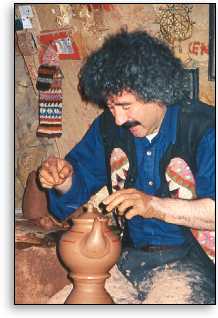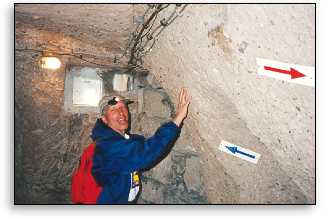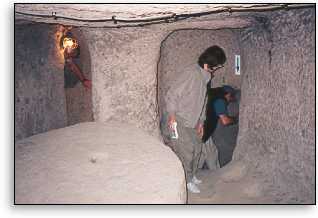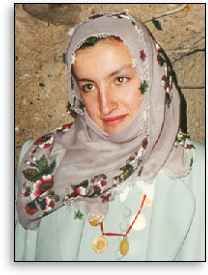Cappadocia, Avanos, Kaymakli, Belisirma, Guzelyurt
Western Turkey - Group Journal
Day 6 -
Thursday, 9 April 1998
by Jim and Jeri Jardine
 8:30 a.m. Left the
Green Motel after breakfast to Avanos, pop. 5,000. We visited the workshop of
the potter Galip. He is a handsome 5th generation potter. Traditionally the
craft is passed from father to son but now Galip has both male and female
students in his classes. Galip demonstrated the traditional method of throwing
pots. He stated that on a good day he can make 1,500 plates if he has a good
kneader.
8:30 a.m. Left the
Green Motel after breakfast to Avanos, pop. 5,000. We visited the workshop of
the potter Galip. He is a handsome 5th generation potter. Traditionally the
craft is passed from father to son but now Galip has both male and female
students in his classes. Galip demonstrated the traditional method of throwing
pots. He stated that on a good day he can make 1,500 plates if he has a good
kneader.
They use a mixture of river and mountain clay for their pots. Galip controls the quality of the works coming out of his studio. He showed the group plates his young daughters had completed by painting.
He has a unique collection of hair strands from visitors to his studio. It filled at least one large room. Each strand was labeled with the persons name and address. The collection made the Guineas Book of Records.
En route to the underground city we passed evidence of the urbanization of Turkey. As evidenced by rows of new apartment buildings the old village ways are giving way to the new era of industrialization. Meli explained the agriculture reforms that have taken place since the early 60's.
 12:30 We arrived in the
underground city. Jim D. initially checked the walls (he is our geologist) and
gave us an impromptu lecture on the difference between tufa and tuff (both are
rock forms). This underground city was carved out of tuff which is igneous
(produced by volcanic action). The city has existed since the Hittite era.
Levels 1-3 were used by the Hittites for daily life with storage of foods and
shelter for animals. During the Roman times the early Christians utilized the
underground cites to escape persecution. They also eluded the 7 - 8th century
Muslim invasion.
12:30 We arrived in the
underground city. Jim D. initially checked the walls (he is our geologist) and
gave us an impromptu lecture on the difference between tufa and tuff (both are
rock forms). This underground city was carved out of tuff which is igneous
(produced by volcanic action). The city has existed since the Hittite era.
Levels 1-3 were used by the Hittites for daily life with storage of foods and
shelter for animals. During the Roman times the early Christians utilized the
underground cites to escape persecution. They also eluded the 7 - 8th century
Muslim invasion.
 The city would hold 1,100
people for periods up to one month. It was totally self contained with a
designated cemetery, a simple church, defensive areas, kitchens, ventilation
system, a birthing area as well as living quarters for families. The birthing
area was the sole area where lamps for light were utilized due to the dangers
of using up the available oxygen. The kitchen area was on the same level as the
well so water was easily available. Forty of these cities have been discovered,
some of them are interconnected via tunnels. This particular city has 9 levels
and is approximately 10% excavated. About 3% is open to the public.
The city would hold 1,100
people for periods up to one month. It was totally self contained with a
designated cemetery, a simple church, defensive areas, kitchens, ventilation
system, a birthing area as well as living quarters for families. The birthing
area was the sole area where lamps for light were utilized due to the dangers
of using up the available oxygen. The kitchen area was on the same level as the
well so water was easily available. Forty of these cities have been discovered,
some of them are interconnected via tunnels. This particular city has 9 levels
and is approximately 10% excavated. About 3% is open to the public.
 While underground, we met a very handsome bridal
couple. She was gracious enough to show us her traditional necklace of large
gold coins which were under her scarf. She also allowed us to photograph her.
While underground, we met a very handsome bridal
couple. She was gracious enough to show us her traditional necklace of large
gold coins which were under her scarf. She also allowed us to photograph her.
Then back to the bus. We passed a flock of sheep being worked by dogs and one shepherd. In the fields seven stones placed on top of each other are a sign to the shepherds that the field has been planted so he does not run his sheep through that field.
Lunch at the "Waist wrapped around with Golden Thread." This was in the poorest village of central Anatolia. We were met by excited children. One climbed upon his burro. A truly unique experience followed after a very nice lunch outside by the river. After lunch we walked up the hill toward the bus and visited a village family in their home. The mother of the house showed us her gold coin necklace and we had a question and answer session. They were very hospitable and served us tea. The children practiced their English. Many photos were taken. We gave a ride on the bus to two young men from the village to a destination down the road.
 5:45 Reached our hotel in
Guzelyurt. There are two underground cities located here. The view is
spectacular with a snow covered mountain, a lake and a village. (Postcard
stuff).
5:45 Reached our hotel in
Guzelyurt. There are two underground cities located here. The view is
spectacular with a snow covered mountain, a lake and a village. (Postcard
stuff).
Meli gave a talk on the town and the history of the hotel. She had arranged for wine and music and ended with a toast to peace, accompanied by Beethoven's ninth.
We had dinner at the hotel. Two couples stayed at local homes, the blue door and the wooden door.